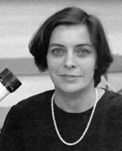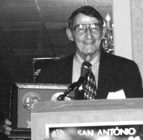She also received the D.A. Brown Medal from the Australian National University.
Banfield has been teaching and doing research in geology and geophysics at UW-Madison since 1990. She is an internationally known mineralogist and is pioneering a new field of science known as geomicrobiology, the study of the role that microorganisms play at the boundary of the Earth and its biosphere.

Professor Jill Banfield
• Professor Jean Bahr has been appointed to the prestigious Committee on Restoration of the Greater Everglades Ecosystem sponsored by the National Research Council of the National Academy of Sciences. The 16-member committee will serve as an advisory panel to review and advise on scientific matters related to the restoration of the South Florida Ecosystem. She was also appointed to a Water Cycle Study Group to advise the U.S. Global Change Research Program on development of a Global Water Cycle Program.
• Professor Chuck DeMets was selected as a Vilas Associate Award for 2000-2002. Chuck was awarded funds to initiate a study of earthquake hazard and plate motion in the state of Oaxaca, Mexico. Professor John Valley received a Vilas Associate Award for 1999-2001 and Professor Phil Brown received a Vilas Assosciate Award for 1998-2000. These prestigious awards are made on a competitive basis by the Graduate School and include summer salary and money for research support.
• Professor Basil Tikoff was awarded a prestigious David and Lucile Packard Fellowship. These five-year fellowships support basic research in the sciences, and only twenty-four are awarded nationally each year. Tikoff's research is focussed on understanding the nature of diffuse deformation within the continental plates, and the role that various layers within the tectonic plates play in distributing the deformation. The grant will fund research on exhumed lower crustal and mantle rocks. Tikoff acknowledges and appreciates the support of the department, which nominated him for this award.
• Professor Alan Carroll was featured in a Madison Capital Times article in November relating his visit to the Johnson Space Center in Houston. He is one of 120 candidates being interviewed by the space program for membership in the astronaut corps. He has applied for a position as mission specialist and would carry out experiments on board the shuttle and help assemble the international space station, if selected.
• Klaus Westphal has won a 1999 Tapestry Award for Excellence in Science Education from the National Science Teachers Association and Toyota Motor Sales.
Lloyd Pray, 1999 Twenhofel Medalist - Robert H. Dott
Once again the SEPM’s highest honor, The Twenhofel Medal, has been awarded to one our own, Emeritus Professor Lloyd C. Pray. For sedimentologists, the Twenhofel is the medal, overshadowing even GSA’s Penrose and AAPG’s Powers Medals. So it seems doubly appropriate when it is given to a member of our Wisconsin department, where sedimentology was practically invented by the medal’s namesake, William H. Twenhofel, seventy odd years ago. (It is also significant that this is the second time in a decade that our sedimentary geology program has been so recognized. Bob Dott received the Twenhofel in 1993–ed. note)

Professor Lloyd Pray
Over the past three decades, we Geo-Badgers have been well aware of Lloyd’s unique genius for conveying both knowledge and wisdom. His enthusiasm and insights have inspired both students and colleagues alike. As he himself prefers, Lloyd will always be remembered best here for his evangelism for field geology in general and for his superb field trips in particular. Outcrops-by-headlight, impromptu lessons in practical cactus taxonomy, and jumping jacks at dawn after a cold night on frozen ground have made him a legend in his own time.
Equally remembered are stimulating lectures and imaginative, challenging laboratory exercises. A bowl of corn flakes or potato chips vividly conveyed the complex fabric of phylloid algal limestones and macaroni of varied shapes immersed in epoxy showed how fossil shells could seem to be free-floating in a thin section. And who could forget "bad water," which conveniently seemed to account for all manner of carbonate depositional and diagenetic mysteries. Most important of all, however, is the declaration by countless students that "Lloyd taught us how to look at rocks!" Lloyd not only inspired many an advanced student, but also neophyte introductory students from freshmen to senior citizen auditors (including one of my own neighbors); only the intellectually still-born could be immune to his enthusiasm and communication skills.
Lloyd went west from his hometown of Ashland, Wisconsin, to Carleton College, then farther west to Cal Tech for his graduate degrees; he then joined the Tech faculty for seven years. In the 1950s, he was lured back eastward by Marathon Oil Co. to join its newly formed research laboratory at Denver, where he initiated a distinguished carbonate research program. While at Marathon, Lloyd quickly became a leader in a dynamic group of carbonate workers, who formed one of the most fruitful collaborations ever seen. We clastic sedimentologists were envious of the mutual stimulation and camaraderie in that group, but our efforts to emulate fell short. SEPM provided the rallying point for the group, and soon Lloyd became active in Society affairs, rising to president in 1969. It was at that same time that he returned east to home turf in Wisconsin to re-enter academia.
Some of Pray’s signal contributions to carbonate sedimentology include the recognition of abundant syndepositional marine carbonate cements when such were considered chemically impossible; recognition that many supposed shoalwater "patch" reefs were actually allochthonous megabreccia blocks; demonstration of the petroleum reservoir potential of phylloid algal buildups; and co-authorship of a very influential classification of porosity types.
Even before receiving the Twenhofel Medal, Lloyd was honored many times for both his research and communication prowess. I think perhaps he is proudest of a 1998 Guadalupe National Park Citation for his contributions to the understanding of that fabulous region.
All who have known and worked with Lloyd Pray have come under the spell of his exceptional communication and mentoring skills, as well as his talent for lateral or maverick thinking in challenging conventional wisdom. Consider, for example, his "all wet" hypothesis for the carbonate rocks of the Guadalupe Mountains proposed and defended vigorously against the onslaught of sequence stratigraphers who were postulating countless sea level fluctuations, the "yo-yo" hypothesis.
We also have been hypnotized by his warm personality, enthusiasm, and humor, and the Wisconsin department is surely the better for his many contributions. I mark it as my personal good fortune to have had Lloyd as colleague and friend for the past three decades! Of course all of us have experienced (and many share) his passion for seeing rocks in the field, our science’s ground truth. One day a few years after he retired, I saw Lloyd poke his head into the carbonate lab, where several students were hunched over their computer screens. Then I heard him exclaim, "Doesn’t anyone look at rocks around here anymore?" That’s our Lloyd!
Harry E. Cook’s citation for the Twenhofel Medal reads
"To Lloyd C. Pray for his memorable and sustained accomplishments in understanding the origin and relevant characteristics of many aspects of carbonate sedimentary rocks, and for being a joyful, trustworthy, and caring person to his family and friends, his students and colleagues, and the geologic community."